Miyagi Prefecture in Japan is home to various bird species, making it an ideal place for birdwatching. Approximately 300 species of birds inhabit the region, including the Japanese Bush Warbler, Grey Heron, and the Grey-headed Woodpecker.
Miyagi is also home to many migratory species, such as the Common Kingfisher and the Grey-headed Lapwing. The prefecture is known for its abundant forests, wetlands, and coastline – all of which provide the perfect habitat for bird species.
With its diverse habitats, Miyagi is the perfect place to observe and admire the beauty of birds in their natural environment.
19 Birds to Watch in Miyagi
Miyagi Prefecture in Japan is home to various bird species, making it an ideal place for birdwatching. Approximately 300 species of birds inhabit the region, including the Japanese Bush Warbler, Grey Heron, and the Grey-headed Woodpecker.
Miyagi is also home to many migratory species, such as the Common Kingfisher and the Grey-headed Lapwing. The prefecture is known for its abundant forests, wetlands, and coastline – all of which provide the perfect habitat for bird species.
With its diverse habitats, Miyagi is the perfect place to observe and admire the beauty of birds in their natural environment.
Here are 19 birds that you can watch in Miyagi:
1. Oriental Turtle Dove
The Oriental turtle dove, also known as the rufous turtle dove, is a species of bird that belongs to the Columbidae family. This species has a wide native distribution range, stretching from Central Asia all the way east across Asia to Japan.
This species has several distinct populations, each identified by its unique plumage patterning. This species has been classified into at least six distinct subspecies based on these differences.
Each of these subspecies has distinct characteristics that set it apart. For example, some subspecies may have a different colour of plumage or a different pattern of markings.
Researchers can better understand this species’ evolution by studying the differences between the various subspecies.
| Kingdom | Animalia |
| Phylum | Chordata |
| Class | Aves |
| Order | Columbiformes |
| Family | Columbidae |
| Genus | Streptopelia |
| Species | S. orientalis |
2. Black Eared Kite
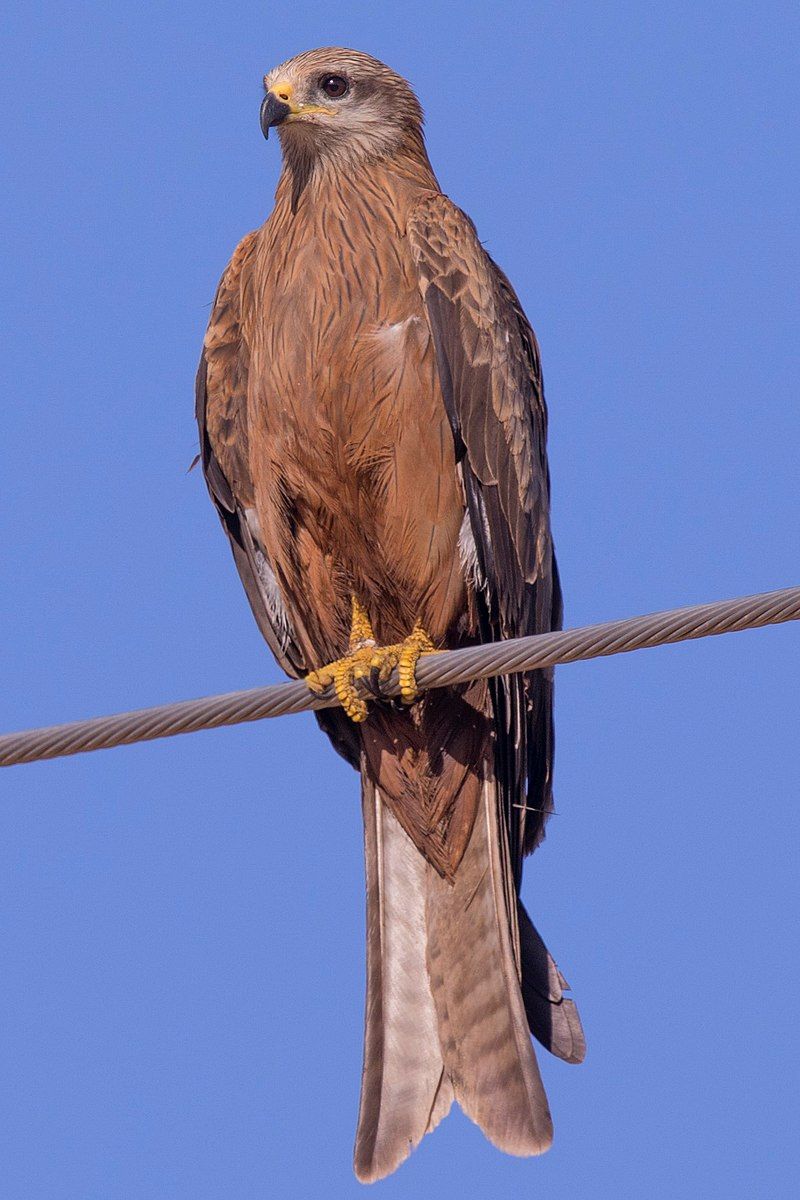
The black kite is a bird of prey belonging to the Accipitridae family. It is a medium-sized bird with a wingspan of up to four feet in many parts of the world.
The black kite is believed to be the most abundant species of Accipitridae, although there have been reports of some populations decreasing or fluctuating. This could be due to various factors, such as habitat destruction or overhunting.
The black kite is a mighty hunter, feeding small mammals, birds, and insects. It is an essential predator in many ecosystems, helping to keep the populations of its prey species in check.
Unfortunately, the black kite is also threatened by human activities, such as poisons and trapping. Conservation efforts are needed to ensure that this species can continue to thrive in the wild.
| Kingdom | Animalia |
| Phylum | Chordata |
| Class | Aves |
| Order | Accipitriformes |
| Family | Accipitridae |
| Genus | Milvus |
| Species | M. migrans |
3. Pygmy Woodpecker
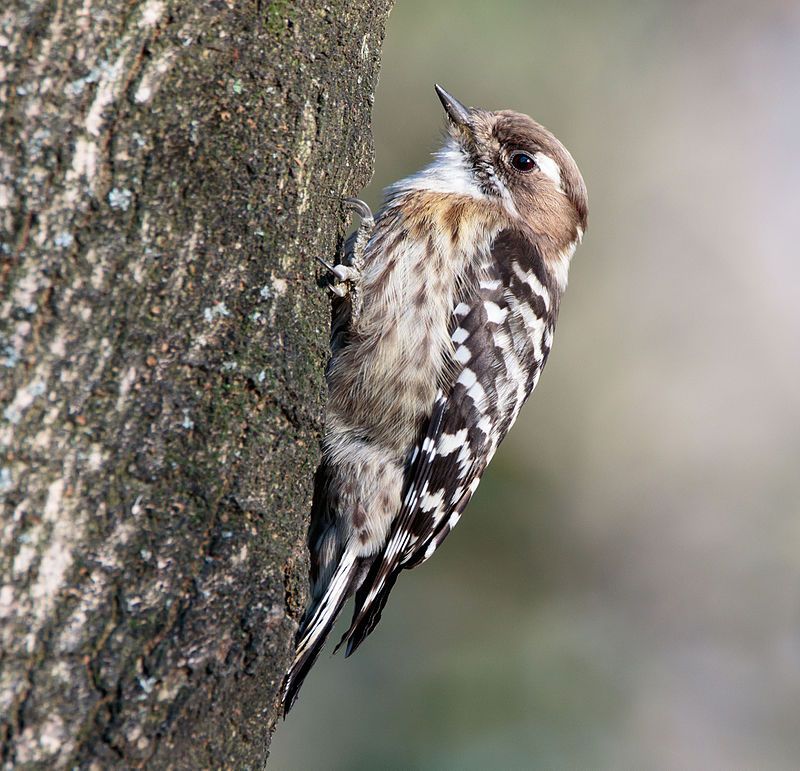
The Japanese Pygmy Woodpecker is a species of woodpecker native to East Asia. It is primarily found in Russia, China, Korea, and Japan’s forested areas. This species has a small body size, hence the name ‘pygmy’.
Its wingspan ranges between 13 and 15 cm, and its bill length is about 2 cm. It has a distinctive black and white spotted plumage, with a white belly, black head, and a white eye-ring.
The Japanese Pygmy Woodpecker feeds mainly on insects but will also feed on fruits and nuts. The species has been placed in two different genera – Dendrocopos and Picoides.
The Dendrocopos genus is a group of woodpeckers, which includes the Eurasian Green Woodpecker and the Grey-headed Woodpecker.
The Picoides genus is a group of woodpeckers, which includes the Downy Woodpecker and the Hairy Woodpecker. The Japanese Pygmy Woodpecker is a non-migratory species that tends to remain in the same region year-round.
It is not known to be threatened by extinction. However, its population is decreasing due to deforestation and habitat destruction. Conservation efforts are being made to protect the species and its habitat.
| Kingdom | Animalia |
| Phylum | Chordata |
| Class | Aves |
| Order | Piciformes |
| Family | Picidae |
| Genus | Yungipicus |
| Species | Y. kizuki |
4. White-Tailed Eagle
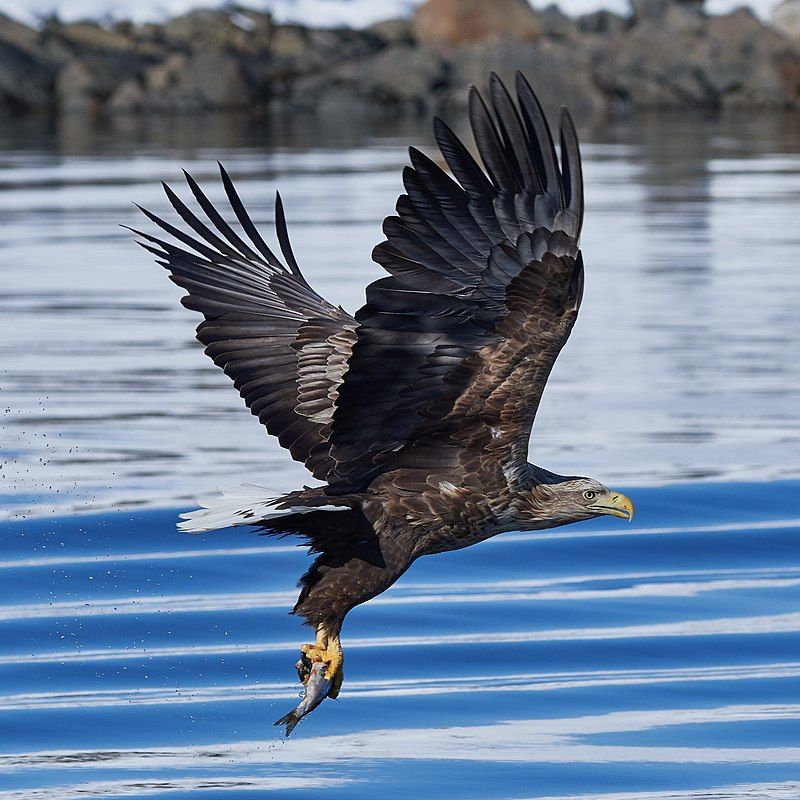
The white-tailed eagle is a large bird of prey belonging to the family Accipitridae. It can be found across temperate parts of Eurasia, inhabiting areas near bodies of water such as rivers, lakes, and oceans.
The white-tailed eagle is also known as the ‘sea eagle’ due to its preference for coastal environments. The Accipitridae family comprises other diurnal raptors, such as hawks, kites, and harriers.
These birds of prey are distinguished by their keen eyesight and sharp talons, which allow them to capture and consume their prey. The white-tailed eagle is no exception, as it is an incredibly agile hunter that uses its sharp vision and formidable claws to catch its prey.
White-tailed eagles are usually solitary birds, but they will congregate in large numbers during the breeding season. They build their nests on tall trees or cliffs, using sticks and other materials to construct a sturdy structure.
These nests can be huge and have been used by the same pair of birds for many years. The white-tailed eagle is an impressive bird of prey widely distributed across temperate Eurasia.
It is a member of the Accipitridae family, which includes other diurnal raptors such as hawks, kites, and harriers. With its mighty wings and sharp vision, the white-tailed eagle is an adept hunter capable of quickly catching its prey
| Kingdom | Animalia |
| Phylum | Chordata |
| Class | Aves |
| Order | Accipitriformes |
| Family | Accipitridae |
| Genus | Haliaeetus |
| Species | H. albicilla |
5. Steller’s Sea Eagle
Steller’s sea eagle is a type of large bird of prey that can be found in the Accipitridae family. It was first described by Peter Simon Pallas in 1811 and is also referred to as the Pacific sea eagle or white-shouldered eagle.
This bird is active during the day and has no recognized subspecies. It is considered one of the world’s most giant birds of prey, with its wingspan reaching up to 2.3 meters. Its body is large, measuring around 85 cm long and weighing up to 8 kilograms.
This bird has black and white plumage, a white head and neck and a black crown and tail. The beak of the Steller’s sea eagle is yellow and hooked, and its paws are large and powerful.
It feeds mainly on fish but consumes small mammals, crustaceans, and other birds. Its habitat is primarily coastal and consists of open waters, wetlands, and rocky cliffs.
The Steller’s sea eagle is a threatened species whose population is declining due to habitat destruction and pollution. Conservation efforts are being made to help protect this species and its habitat.
| Kingdom | Animalia |
| Phylum | Chordata |
| Class | Aves |
| Order | Accipitriformes |
| Family | Accipitridae |
| Genus | Haliaeetus |
| Species | H. pelagicus |
6. Eastern Spot-Billed Duck
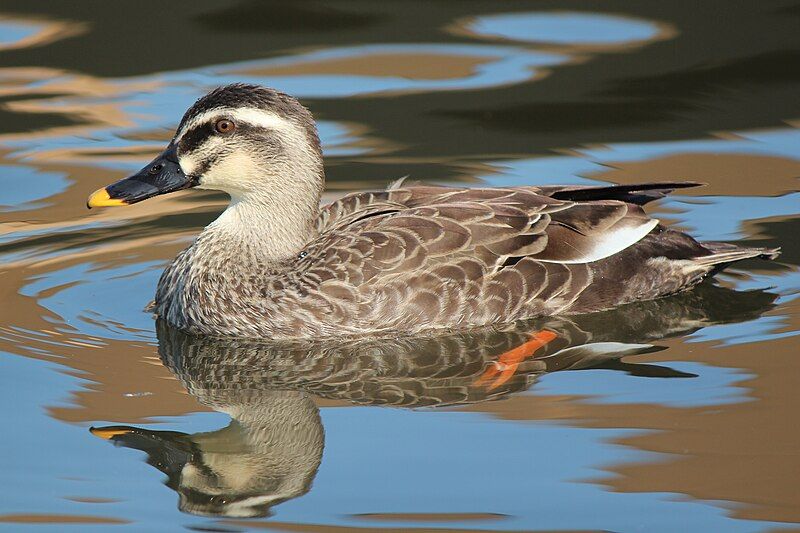
The eastern spot-billed duck, also known as the Chinese spot-billed duck, is a dabbling duck found in East and Southeast Asia.
This species was previously thought to be a subspecies of the Indian spot-billed duck, and the two were both referred to as the spot-billed duck. The name of the eastern spot-billed duck is derived from the yellow spot on the duck bill.
The yellow spot on the bill is unique to this species and is not found in other ducks. The eastern spot-billed duck has a brown and white body with a distinctive white patch on its head. It also has a long and slender bill with a yellow spot on the tip.
The yellow spot is a vital identification feature of the species and helps distinguish it from other ducks.
The eastern spot-billed duck is also quite large, with a wingspan of up to 70 cm. The eastern spot-billed duck is an aquatic bird typically found in shallow wetlands, rivers, lakes, and marshes. It feeds on aquatic plants, insects, crustaceans, and molluscs.
The eastern spot-billed duck is also known to be a social bird, often found in large flocks. The eastern spot-billed duck is an essential species in East and Southeast Asia, both ecologically and culturally.
It is a famous game bird and an important food source for many local communities. The species is also crucial to the local ecosystem, providing essential nutrients and helping to maintain habitat health.
| Kingdom | Animalia |
| Phylum | Chordata |
| Class | Aves |
| Order | Anseriformes |
| Family | Anatidae |
| Genus | Anas |
| Species | A. zonorhyncha |
7. Great Egret
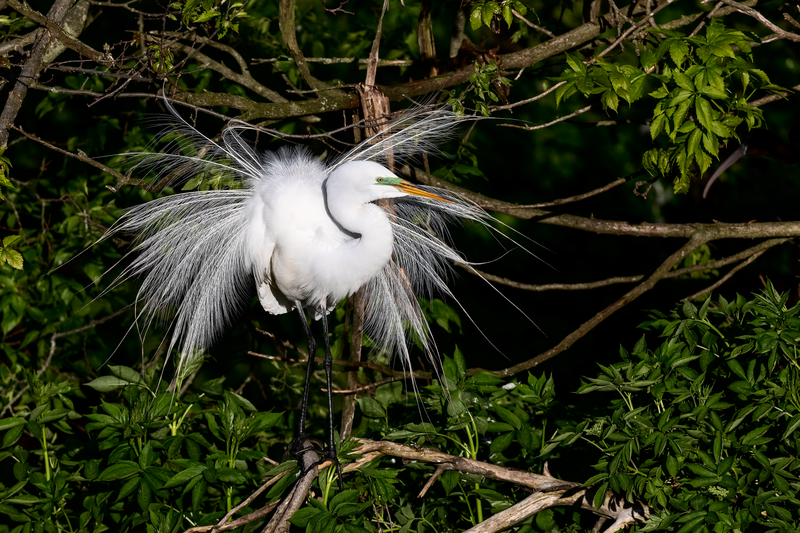
The great egret is a large bird native to many parts of the world, including Asia, Africa, the Americas, and southern Europe. Several other names, including the common egret, large egret, great white egret, and great white heron, also know it.
Its range has expanded in recent years, with the species now being spotted in more northern areas of Europe. The great egret is considered a medium-sized heron, typically standing between two and three feet tall with a wingspan of nearly four feet wide.
It has a slender body, a long neck, and a long, pointed bill. Its plumage is primarily white, although its wings and back may have a slight green or greyish tint.
The great egret’s long legs are black, and its feet are yellow. The great egret is an opportunistic feeder, eating various small animals, such as fish, frogs, insects, and some plant matter.
During the breeding season, it is often seen wading in shallow waters, searching for prey.
Great egrets are highly social birds, usually nesting in colonies with other water birds. The great egret is a widely distributed species considered the least concerning by the International Union for Conservation of Nature.
However, its population has declined due to habitat loss, degradation, and being hunted for its feathers. Conservation efforts are currently underway to protect this species and its habitat.
| Kingdom | Animalia |
| Phylum | Chordata |
| Class | Aves |
| Order | Pelecaniformes |
| Family | Ardeidae |
| Genus | Ardea |
| Species | A. alba |
8. Grey Heron
The grey heron is a species of wading bird part of the heron family, Ardeidae. It is found in temperate regions of Europe, Asia, and parts of Africa. It is a resident species in a range, meaning it does not migrate from these areas.
However, some of its populations located in the more northern parts of its range migrate southwards during the autumn months. This species has long legs, which it uses to wade in shallow waters, searching for food.
Its long neck and bill also help it catch prey, including fish, amphibians, and invertebrates. The grey heron is a majestic sight, with its grey and white feathers and striking yellow eyes.
| Kingdom | Animalia |
| Phylum | Chordata |
| Class | Aves |
| Order | Pelecaniformes |
| Family | Ardeidae |
| Genus | Ardea |
| Species | A. cinerea |
9. Japanese Wagtail
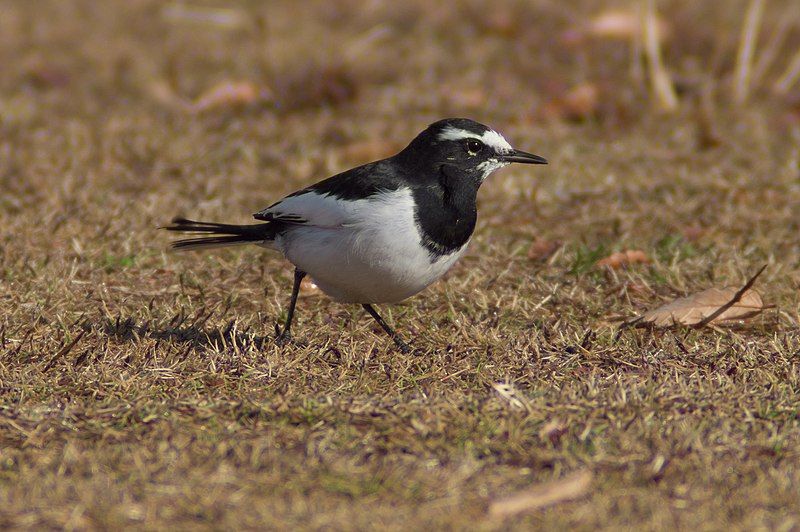
The Japanese Wagtail is a small, attractive bird in the pipit and wagtail family Motacillidae. It is a migratory species found in Japan and Korea during different times of the year.
Its appearance is distinctive, with a black crown, white throat, and a white breast with a black patch on the sides. The upper parts, wings, and tail are greyish-brown, and the tail is often held upright.
The tail is also known to sway from side to side, so this species is sometimes called a wagtail. The Japanese Wagtail is a social species, often found in small flocks hunting for insects near the ground.
Its diet consists mainly of insects, such as grasshoppers, beetles, and small butterflies. It also feeds on small invertebrates, such as worms, snails, and spiders.
The Japanese Wagtail is a territorial species, and its song is a loud, melodious trill. This species is considered to be of least concern by the International Union for Conservation of Nature, as it is a common bird that is not under threat of extinction.
It is also a famous bird with birdwatchers, who flock to Japan and Korea to glimpse this beautiful species.
| Kingdom | Animalia |
| Phylum | Chordata |
| Class | Aves |
| Order | Passeriformes |
| Family | Motacillidae |
| Genus | Motacilla |
| Species | M. grandis |
10. Eastern Buzzard
The eastern buzzard, or Japanese buzzard, is a species of bird of prey found east of Eurasia. It is part of the same genus as the common predator in most of Europe, Asia, and Africa.
While the two species share many similarities, the eastern buzzard is typically more giant than its standard counterpart. In 2008, some scientists argued that the east buzzard should be classified as a distinct species, separate from the common buzzard.
However, there is still some debate over whether the eastern buzzard should be considered its species or if it should be classified as one or three subspecies of the common buzzard. This debate is ongoing, and it is unclear when a resolution may be reached.
The eastern buzzard has several distinct characteristics that set it apart from the common buzzard. Its head is usually more rounded, its wings are more slim and pointed, and its tail is generally shorter.
It also has a more robust and direct flight than the common buzzard.
Furthermore, the eastern buzzard has a slightly different diet than its European counterpart, with a preference for small mammals, reptiles, and insects. Overall, the eastern buzzard is a fascinating species of bird of prey distinct from the common buzzard.
While there is still some debate as to whether it should be considered its species or a subspecies of the common predator, it is clear that the two birds have some distinct differences that set them apart.
| Kingdom | Animalia |
| Phylum | Chordata |
| Class | Aves |
| Order | Accipitriformes |
| Family | Accipitridae |
| Genus | Buteo |
| Species | B. japonicus |
11. Oriental Greenfinch
The grey-capped Greenfinch, or Oriental Greenfinch, is a small passerine bird species in the finch family Fringillidae. This bird species is in the East Palearctic region, living in both broadleaf and conifer woodlands.
The grey-capped Greenfinch is a medium-sized finch measuring 12.5 to 14 cm long with a substantial bill and a short, slightly forked tail. This bird species is easily identified by its striking grey and green plumage, with a distinct grey cap on its head.
The grey-capped Greenfinch is an omnivorous species, feeding on plants such as seeds, fruits, buds, insects, spiders, and other invertebrates.
During the breeding season, which generally occurs between May and July, the grey-capped Greenfinch builds a nest in a tree or shrub made of grass, moss, and other materials and lays a clutch of 4 to 5 eggs. The female incubates the eggs for 12 to 14 days before hatching.
The grey-capped Greenfinch is an important species to the East Palearctic ecosystem, playing a role in seed dispersal and acting as a food source for other species.
Despite this, the population of this species is declining due to loss of habitat, climate change, and other factors. It is essential to conserve the grey-capped Greenfinch and its habitat.
| Kingdom | Animalia |
| Phylum | Chordata |
| Class | Aves |
| Order | Passeriformes |
| Family | Fringillidae |
| Genus | Chloris |
| Species | C. sinica |
12. Eastern Marsh Harrier
The eastern marsh harrier is a species of bird of prey belonging to the marsh harrier group. This species was once classified as the same species as the western marsh harrier, but it is usually treated as a separate species today. It has two subspecies, C. s.
spilonotus found in eastern Asia and C. s. spilothorax in New Guinea. These two subspecies differ slightly regarding physical characteristics, habitat preferences, and behaviour. The eastern marsh harrier is a medium-sized species with a 50 to 60 centimetres wingspan.
It is a relatively agile bird that prefers hunting in marshy areas. Its diet consists mainly of small mammals and insects, although it will also feed on small birds and reptiles.
The species is typically found in open fields, wetlands, and other marshy areas, particularly in areas of low vegetation. It is a common species, although its population has declined in some areas due to habitat loss, hunting, and other forms of human disturbance.
| Kingdom | Animalia |
| Phylum | Chordata |
| Class | Aves |
| Order | Accipitriformes |
| Family | Accipitridae |
| Genus | Circus |
| Species | C. spilonotus |
13. Eurasian Kestrel
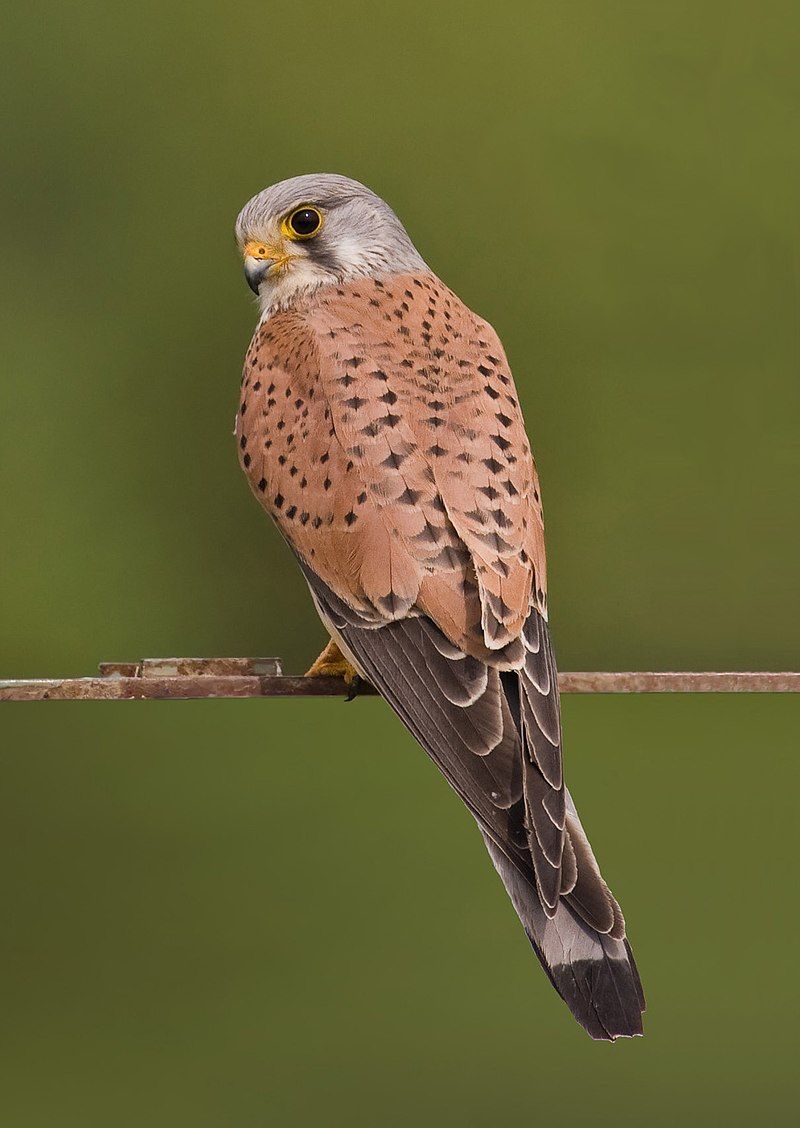
The common kestrel is a member of the kestrel group of the falcon family Falconidae and is native to Europe, Asia and parts of North Africa. It is a bird of prey, meaning it hunts and feeds on other animals.
Various names, including the European, Eurasian, and Old World kestrel, also know it. In the United Kingdom, where no other kestrel species are present, it is called the “kestrel”.
The common kestrel is a medium-sized bird with a wingspan of around 50 cm and can be identified by its brown upperparts, pale underparts and distinctive black and white tail feathers. It has a sharp, hooked bill, long, pointed wings and powerful talons.
It feeds mainly on small mammals, such as voles and mice, insects, lizards, snakes and smaller birds.
It inhabits open habitats such as grasslands, meadows, farmland, and marshes. The common kestrel is an essential species in its range and is often used to control rodent populations. It is also a famous bird for falconry and is usually kept as a pet.
It is listed as a species of most minor concern on the IUCN Red List.
| Kingdom | Animalia |
| Phylum | Chordata |
| Class | Aves |
| Order | Falconiformes |
| Family | Falconidae |
| Genus | Falco |
| Species | F. tinnunculus |
14. White-Naped Crane
The white-naped Crane is a spectacular bird in the crane family. It is a large bird, standing 130 cm tall and weighing around 5.6 kg.
It displays a unique combination of colours: elegant pinkish legs, a stunning grey-and-white-striped neck, and a striking red face patch. Its overall length measures anywhere from 112-125 cm.
Many bird enthusiasts consider the white-naped Crane one of the most beautiful birds.
| Kingdom | Animalia |
| Phylum | Chordata |
| Class | Aves |
| Order | Gruiformes |
| Family | Gruidae |
| Genus | Antigone |
| Species | A. vipio |
15. Japanese Green Pheasant
The green pheasant, also known as the Japanese green pheasant, is an omnivorous bird found only in the Japanese archipelago. It is a unique bird species and is Japan’s national bird.
Some taxonomic authorities believe it to be a subspecies of the common pheasant, Phasianus colchicus. The green pheasant is an omnivore, meaning it feeds on a diverse diet of plants and animals. It typically eats seeds, shoots, leaves, fruits, berries, and insects.
It is usually found in forests, woodlands, grasslands, and scrublands and may be seen alone or in small groups. The green pheasant is a medium-sized bird with a long tail and slender legs.
It has a bright green head and neck, a black face, and a reddish-brown body with white barring on its wings and tail. The green pheasant is an essential species in Japan and has been a symbol of prosperity and good luck for centuries.
It symbolizes national pride and is featured on coins, stamps, and other official documents. The green pheasant is listed as a species of Least Concern by the International Union for Conservation of Nature.
Despite this, its population is believed to be decreasing due to habitat destruction and hunting. As such, protecting its habitat and regulating hunting is essential to help conserve this unique species for generations.
| Kingdom | Animalia |
| Phylum | Chordata |
| Class | Aves |
| Order | Galliformes |
| Family | Phasianidae |
| Genus | Phasianus |
| Species | P. versicolor |
16. Blue Rock Thrush
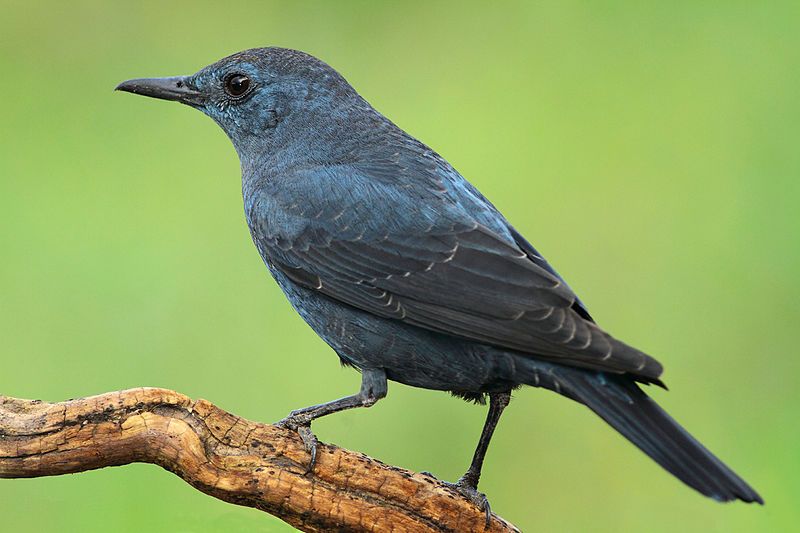
The blue rock thrush is a species of chat, an Old World flycatcher. It is classified under Turdidae and is known for its thrush-like appearance and behaviour.
This bird species can be found in various geographical locations, specifically southern Europe, northwest Africa, Central Asia, northern China, and Malaysia.
It is known to breed in these areas and is commonly found in rocky and mountainous regions. The blue rock thrush has a bright blue plumage and is recognized for its distinctive call. They are omnivorous and feed on insects, fruit, and other small prey.
These birds are known to be very territorial and will fiercely defend their breeding grounds.
They will also migrate during the winter and can travel long distances to reach warmer climates. The blue rock thrush is a common species, but its population has decreased in recent years due to habitat loss and degradation.
Conservation efforts are being made to protect this species and its habitat to ensure its survival for future generations.
| Kingdom | Animalia |
| Phylum | Chordata |
| Class | Aves |
| Order | Passeriformes |
| Family | Muscicapidae |
| Genus | Monticola |
| Species | M. solitarius |
17. Varied Tit
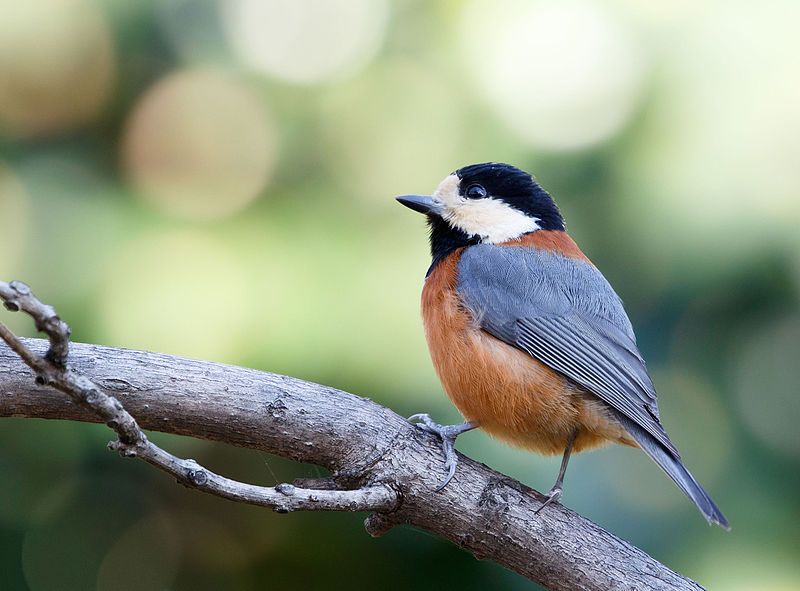
The varied tit is a species of perching bird belonging to the Paridae family of birds. This species is native to the eastern Palearctic region, which includes Japan, Korea, and parts of northeastern China and southeastern Russia.
The variety is easily recognizable by its greyish-brown head, white cheeks, and yellowish breast. It has a black line that runs from its bill to the back of its head and a white stripe from its bill to its forehead.
This species is also characterized by its white underparts and black wings with white spots. In addition to their attractive plumage, the varied tit has a call that is distinctive and easily recognizable.
The variety is generally found in deciduous and coniferous forests, as well as in gardens and parks. They feed on small insects, seeds, and fruit.
The varied species are essential for their role in controlling insect populations and dispersing seeds and, therefore, are a critical component in the Palearctic’s biodiversity.
| Kingdom | Animalia |
| Phylum | Chordata |
| Class | Aves |
| Order | Passeriformes |
| Family | Paridae |
| Genus | Sittiparus |
| Species | S. varius |
18. Eurasian Sparrowhawk
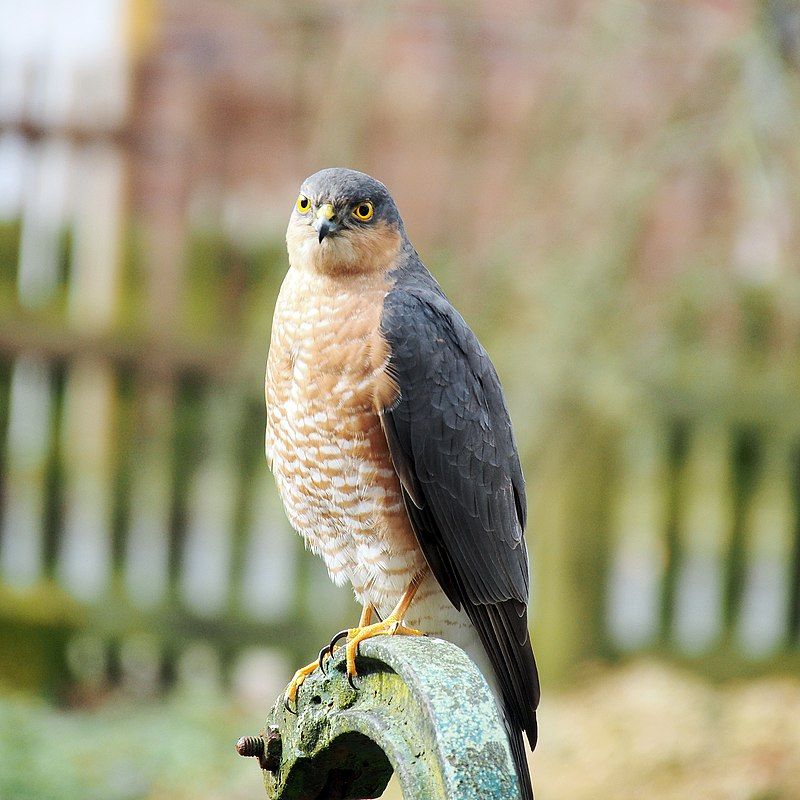
The Eurasian sparrowhawk is a small bird of prey species belonging to the Accipitridae family. It is sometimes referred to as the northern sparrowhawk or simply the sparrowhawk.
Adult male Eurasian sparrowhawks have a distinct plumage, featuring bluish-grey upperparts and orange-barred underparts. The females and juveniles are brown watercolour, with barring on their undersides.
The overall appearance of the species, in terms of size and colouring, can vary depending on the region in which they are found. For example, those found in the northern parts of their range tend to be larger and darker in colour.
The Eurasian sparrowhawk is a diurnal hunter who is active during the day. They mainly hunt small birds and mammals and use a combination of speed and agility to catch their prey.
They have several adaptations that help them to be successful hunters, such as powerful talons and sharp eyesight. The Eurasian sparrowhawk is widely distributed throughout Europe and Asia, inhabiting various habitats such as forests, grasslands, and urban areas.
The Eurasian sparrowhawk is listed as a species of most minor concern on the IUCN Red List. This is due to its wide range and stable population numbers.
However, there are still some threats to the species, such as habitat loss and the use of pesticides, that may affect the population in the future. As such, measures must be taken to protect this species and its habitat.
| Kingdom | Animalia |
| Phylum | Chordata |
| Class | Aves |
| Order | Accipitriformes |
| Family | Accipitridae |
| Genus | Accipiter |
| Species | A. nisus |
19. Northern Goshawk
The Eurasian goshawk is a medium-large bird of prey belonging to the family Accipitridae, a group of birds known as diurnal raptors active during the day. This family also includes eagles, buzzards, and harriers.
The Eurasian goshawk belongs to the genus Accipiter, which is a type of hawk that is often considered to be a true hawk. The Eurasian goshawk is a powerful bird of prey that hunts by surprise, using its sharp eyesight and speed to catch its prey.
This bird species is found in various areas of Europe and Asia and is adapted to habitats ranging from woodlands to open fields. The Eurasian goshawk is a solitary bird that generally breeds in pairs but may form small flocks during migration.
It has many vocalizations, including a distinctive call often heard during courtship. The Eurasian goshawk is an essential bird species in its habitat, as it helps keep the populations of prey species balanced.
| Kingdom | Animalia |
| Phylum | Chordata |
| Class | Aves |
| Order | Accipitriformes |
| Family | Accipitridae |
| Genus | Accipiter |
| Species | A. gentilis |
Conclusion
Miyagi Prefecture offers enthusiasts and nature lovers a captivating array of bird species. With its diverse coastal and mountainous landscapes, Miyagi provides habitats for various avian life.
From the majestic Steller’s Sea Eagle to the elegant Japanese Crane, each species contributes to the rich tapestry of biodiversity in the region.
Whether observing migratory birds along the coastline or exploring lush forests teeming with songbirds, Miyagi presents endless opportunities for birdwatching enthusiasts to connect with nature and appreciate the beauty of these winged creatures.